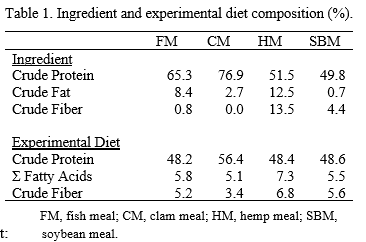NUTRIENT AVAILABILITY FROM CLAM MEAL AND HEMP MEAL IN FLORIDA POMPANO Trachinotus carolinus
There is a growing demand for alternative feed ingredients to replace traditional rendered fish meal (FM) and fish oil (FO). Fish feed manufacturers are relying on an increasingly diverse array of alternative feedstuffs of plant, animal, and microbial origins. These alternatives are complex and require further investigation to determine their nutritional value, productivity, and profitability. The transition from dependence on FM and FO cannot be accomplished without accurate information on the nutritional value of prospective alternatives. This requires both the compositional and availability of nutrients from these alternatives. Product availability, ease of use, relative safety for animals, and nutritional value relative to cost are the drivers that affect the extent to which underutilized and new ingredients are used.
The objective of this study was to determine the availability of nutrients (proximate components, amino acids, fatty acids) to Florida pompano from clam meal and hemp meal. A basal diet meeting the known requirements for Florida pompano, and three test ingredients were evaluated as a completely randomized design, with four replicate tanks per diet. The three test ingredients clam meal, hemp meal, and soybean meal (Table 1) were substituted at 300 g/kg for 300 g/kg of the basal diet (30:70 w/w test ingredient: basal diet). The basal diet incorporated yttrium oxide (Y2O3) at 0.5% of the diet as an inert marker for determining apparent digestibility/availability coefficients.
Feed and pooled fecal samples were evaluated for N, energy, total lipid, organic matter, and Yttrium. Feed, and fecal samples were also evaluated for amino acid and fatty acid content. Apparent nutrient digestibility coefficients for each ingredient were calculated based on the ratios of nutrient and marker in feed and feces.
The overall goal was to produce descriptive statistics on nutrient availability for two novel feed ingredients, clam meal and hemp meal. Nutrient availability values for SBM are known and serve as a baseline for validation. In addition, comparing nutritional values in clam meal and hemp meal relative to SBM gives insight into their biological value relative to SBM in Florida pompano diets. These digestibility values can then be applied for future business and research applications.
